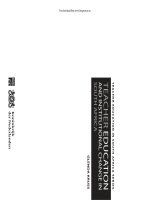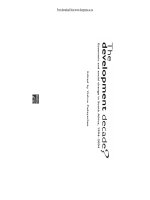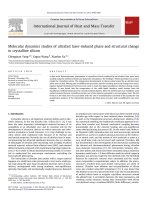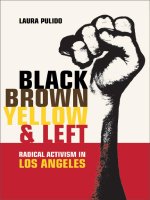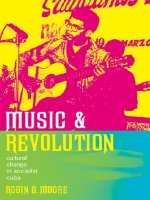music and revolution cultural change in socialist cuba apr 2006
Bạn đang xem bản rút gọn của tài liệu. Xem và tải ngay bản đầy đủ của tài liệu tại đây (5.28 MB, 367 trang )
music of the african diaspora
Edited by Samuel A. Floyd, Jr., and Rae Linda Brown
1. California Soul: Music of African Americans in the West, edited
by Jacqueline Cogdell DjeDje and Eddie S. Meadows
2. William Grant Still: A Study in Contradictions, by Catherine Parsons
Smith
3. Jazz on the Road: Don Albert’s Musical Life, by Christopher Wilkinson
4. Harlem in Montmartre: A Paris Jazz Story between the Great Wars,
by William A. Shack
5. Dead Man Blues: Jelly Roll Morton Way Out West, by Phil Pastras
6. What Is This Thing Called Jazz?: African American Musicians as Artists,
Critics, and Activists, by Eric Porter
7. Race Music: Black Cultures from Bebop to Hip-Hop, by Guthrie P.
Ramsey, Jr.
8. Lining Out the Word: Dr. Watts Hymn Singing in the Music of Black
Americans, by William T. Dargan
9. Music and Revolution: Cultural Change in Socialist Cuba, by Robin D.
Moore
10. From Afro-Cuban Rhythms to Latin Jazz, by Raul A. Fernandez
Music and Revolution
Cultural Change in Socialist Cuba
robin d. moore
University of California Press
Berkeley Los Angeles London
Center for Black Music Research
Columbia College Chicago
University of California Press, one of the most distinguished
university presses in the United States, enriches lives around the
world by advancing scholarship in the humanities, social sciences,
and natural sciences. Its activities are supported by the UC Press
Foundation and by philanthropic contributions from individuals
and institutions. For more information, visit www.ucpress.edu.
University of California Press
Berkeley and Los Angeles, California
University of California Press, Ltd.
London, England
Center for Black Music Research
Columbia College, Chicago
© 2006 by The Regents of the University of California
Library of Congress Cataloging-in-Publication Data
Moore, Robin, 1964–.
Music and revolution : cultural change in socialist Cuba / Robin D.
Moore.
p. cm. — (Music of the African diaspora)
Includes bibliographical references (p. ) and index.
isbn 0-520-24710-8 (cloth : alk. paper).—isbn 0-520-24711-6 (pbk. :
alk. paper)
1. Music—Political aspects—Cuba. 2. Music—Cuba—20th
century—History and criticism. 3. Socialism and music. I. Title.
II. Series.
ml3917.c9m66 2006
780'.97291'0904—dc22 2005022138
Manufactured in the United States of America
15 14 13 12 11 10 09 08 07 06
10987654321
This book is printed on New Leaf EcoBook 50, a 100% recycled fiber
of which 50% is de-inked post-consumer waste, processed chlorine-
free. EcoBook 50 is acid-free and meets the minimum requirements
of ansi/astm d5634-01 (Permanence of Paper).
Qué rumbo al futuro más infortunado
qué nueva frontera hemos violado
qué camino más estrecho andamos
cuánto corazón juntamos
gerardo alfonso, “Amiga mía”
Contents
List of Illustrations ix
Preface xi
Introduction: Music and the Arts in Socialist Cuba 1
1. Revelry and Revolution: The Paradox of the 1950s 26
2. Music and Social Change in the First Years 56
3. Artistic Institutions, Initiatives, and Policies 80
4. Dance Music and the Politics of Fun 107
5. Transformations in Nueva Trova 135
6. Afro-Cuban Folklore in a Raceless Society 170
7. Ay, Dios Ampárame: Sacred Music and Revolution 197
8. Music and Ideological Crisis 225
Conclusion: Musical Politics into the New
Millennium
251
Appendix: Publications on Music from
Revolutionary Cuba
265
Notes 275
Glossary 307
Works Cited 317
Index 341
Illustrations
figures
1. “Venceremos” 9
2. “Himno de la Demajagua” 14
3. Impoverished La Timba neighborhood, 1951 31
4. Floor show in the Cabaret Montmartre 43
5. Carlos Puebla y sus Tradicionales 59
6. Striking workers protest the closure of casinos 62
7. Revolutionary cultural leaders 84
8. Amateurs’ festival announcement 87
9. Students at the National School of Art, 1964 96
10. Los Van Van 114
11. Irakere 117
12. Liena Hernández Senteno and Bamboleo 128
13. Pablo Milanés 144
14. Silvio Rodríguez 146
15. Gema Corredera and Pável Urkiza 165
16. Pacho Alonso y sus Bocucos 180
17. Pello el Afrokán and ensemble 183
18. Rumba performance in the Callejón de Hamel 192
19. Amateur folklore ensemble Isupo Irawó 206
20. The Conjunto Folklórico Nacional 216
ix
21. Tourist T-shirt art, 1990s 231
22. Cover art, Charanga Habanera CD Pa’ que se entere La Habana 243
music examples
1. José Fajardo, chachachá segment 47
2. Benny Moré, “Mi sacoco” 51
3. Los Van Van, songo rhythmic sketch 116
4. Issac Delgado, montuno patterns 124
5. NG La Banda, iyesá rhythm 126
6. Pablo Milanés, “Son de Cuba a Puerto Rico” 140
7. Carlos Varela, “Cuchilla en la acera” 163
8. Gema y Pável, “Habana, devorando claridad” 166
9. Enrique Bonne’s pilón rhythm, performed by José Luis
Quintana and Yaroldi Abreu Robles 179
10. Mozambique rhythm, performed by Kim Atkins 181
11. Lázaros Ros and Mezcla, religious fusion-rock 219
12. Adalberto Álvarez, chant to Ochún from “¿Y qué tú
quieres que te den?” 221
13. Orishas, traditional guajeo from “A lo cubano” 246
x/Illustrations
Preface
In retrospect, the process of my growing interest in Cuban music and his-
tory over the past fifteen years has been somewhat fortuitous and deserves
explanation. I grew up in Southern California, surrounded by Latin Amer-
ican culture, but, as in the case of far too many Anglo Americans, largely
oblivious to it.My family and friends had virtually no contact with the large
Hispanic population in the area aside from casual acquaintances. After en-
tering college and deciding to pursue music, I was encouraged to take Ger-
man, ostensibly the “best” language choice for my major in the conserva-
tive environment that prevailed.I did so and found that I enjoyed languages;
shortly thereafter, I spent a year on exchange in Austria. The trip made a
lasting impact in many ways, but perhaps most importantly changed my
perspective on the United States, raising my awareness of cultural differ-
ence.After my return,I began for the first time to take serious note of Span-
ish speakers in the area. Continuing to study German seemed silly given
the demographics of the Southwest. I soon made the decision to switch to
Spanish.
In an attempt to combine the study of language, travel, and music, I en-
tered graduate school at UC Santa Barbara in ethnomusicology, a new pro-
gram there. My professors offered excellent courses on a variety of subjects
but little specifically on Latin America. I felt strongly about pursuing work
that would be relevant to the region I lived in, and for that reason eventu-
ally transferred to the University of Texas at Austin. There I began to play
in a mariachi band, learned something about Andean music, and slowly be-
came more familiar with Caribbean styles. The percussiveness and overall
sound of Afro-Latin music in all its permutations (Brazilian, Colombian,
Cuban,Puerto Rican,etc.) attracted me a great deal,as they have many North
Americans. Undoubtedly this is because U.S. and Afro-Latin popular styles
xi
share many features,most notably the fusion of elements derived from sub-
Saharan Africa and Europe.They are related musical systems with common
roots in colonialism, slavery, and cultural adaptation. Each has influenced
the other time and again for at least a century and a half, so their identities
have become closely entwined.
From the few books available on Latin American popular music, I could
tell that prerevolutionary Cuba had been surprisingly influential. Older
recordings in record stores of boleros and dance music—very little from the
socialist period could be purchased before 1993—struck me as an intrigu-
ing combination of the familiar and the different.They were similar in many
ways to the songs my parents had played at home from the big band era.
Knowing little of contemporary politics or how difficult it might be to study
on the island, I found myself concentrating more and more on Cuba. By the
time I began to establish professional contacts there and had some idea of
the complexity of the situation, it was too late to change focus; I had already
invested years in background reading, a plan of study, and other prepara-
tions. Thankfully, two of my professors, Gerard Béhague and Aline Helg,
helped me secure modest research support that enabled me to spend a total
of about twelve months in Havana between 1992 and 1994. My investiga-
tion at that time involved the racial politics of music making in the 1930s.
It focused on an artistic movement similar to the Harlem Renaissance known
as afrocubanismo (Moore 1997).
I arrived in Cuba shortly after the former Soviet Union ended its thirty-
year commitment to underwriting the country’s economy. Support it had
provided in the form of development aid, technical assistance, and military
supplies disappeared overnight. This, in conjunction with the U.S. embargo
and the inexperience of the country in fending for itself in the capitalist mar-
ketplace, had horrific consequences for the Cuban people and the nation as
a whole.The individuals I met in museums,libraries,and private homes had
experienced a precipitous drop in their standard of living.They did not have
enough food to feed their families. They endured daily power outages of
eight to ten hours, lived without running water for extended periods, and
suffered from a lack of medicine and countless other deprivations.The period
naturally gave rise to growing unrest and a marked increase in police vigi-
lance. Simply put, socialist Cuba was in the midst of a grave crisis.
My interest in the post-1959 period derives from firsthand exposure to
all this, beginning in 1991.While interviewing musicians and working with
seventy-year-old recordings,the volatile reality surrounding me constantly
imposed itself and demanded attention.Every aspect of it confused me.Why
were all the shops empty? Why did clerks have to sit idly in them anyway?
xii / Preface
How could that man be arrested for selling green peppers on the street? Why
was foreign currency illegal? Why weren’t Cubans allowed to travel abroad?
What was a ley de peligrosidad? My experience in Cuba during the early
1990s can only be described as schizophrenic. I continued to pursue histor-
ical research, yet most of my conversations with friends and acquaintances
revolved around contemporary events.Even questions posed to interviewees
about the 1930s would often evoke comparisons between prerevolutionary
and postrevolutionary life.Learning about modern Cuba has been a difficult
process, involving reflections on firsthand experience and on the analysis of
others. No country is easy for foreigners to understand upon first arrival,
but socialist Cuba presents special challenges. Aside from its unique, highly
colloquial Spanish and its amazingly complex cultural traditions, its polit-
ical culture and social organization are now radically different from what
most Westerners are accustomed to.
A postdoctoral fellowship in 1996 at the Center for Black Music Research
in Chicago allowed me to begin reading in earnest about the Cuban Revo-
lution as well as to go back to the island for a few more months. Initially, I
focused on topics related to race and African-derived culture. I hoped to ex-
tend my earlier work and determine which art forms had received support
after 1959. Soon, however, I felt the need to expand the scope of inquiry. It
seemed clear that the same policies that had supported and constrained the
black community at various times had significantly impacted other groups.
I also found myself getting interested in the role of the state in cultural plan-
ning. Many artists had achieved a high degree of technical skill in govern-
ment schools, and the music I heard performed even by nonprofessionals
struck me as original and of high quality. By the same token, performers
complained of limitations on their careers and of complications with the gov-
ernment bureaucracy. I began to read about cultural development in other
socialist countries and to try to understand Cuba in that context.
All of the above has resulted in a study that uses the performing arts as
a means of examining larger processes of revolutionary change.Cuba’s pre-
eminence in that area would seem to justify the approach; its music and
dance, not only its politics, have cast a “gigantic shadow” throughout the
Americas and beyond (Kirk and Padura Fuentes 2001:xviii). Artists such as
Silvio Rodríguez and Pablo Milanés have become symbols of progressive
cultural movements throughout the Spanish-speaking world; they and the
many other performers who continue to embrace the revolution—such as
Alicia Alonso, Frank Fernández, Chucho Valdés—generate considerable
sympathy for it.
To supporters of socialist Cuba, this study will probably seem overly crit-
Preface / xiii
ical, while to others it may appear “soft.” I have tried to keep the analysis
as balanced as possible and to create a book potentially useful to readers on
and off the island. I consider myself sympathetic to the goals of socialism
and believe that many of its basic precepts are more humane than those driv-
ing decision making in capitalist countries. However, this has not blinded
me to the oppressiveness of many aspects of life in Cuba today. I hope that
readers on the left and right of the political spectrum will agree that it serves
no one’s interest to gloss over mistakes made by any government. Political
agendas, however well intended, are not furthered by mass rallies or flag
waving, but rather by a careful examination of their successes and failures
and attempts to improve them. Authors living in Cuba should be leading
the way in discussing the long-term impact of cultural changes over the past
forty-five years. Unfortunately, before the mid-1990s, they generated little
in the way of self-reflective criticism.Visitors with an interest in Cuba,such
as myself,thus have little choice but to raise some topics of discussion them-
selves.The primary goal of this book is not to have its interpretations proven
“right” or “wrong,” although I hope they will stand some scrutiny, but sim-
ply to broaden the dialogue about lessons to be learned from the revolu-
tionary experience.
My attempt to synthesize major cultural trends over the past forty years
has been a humbling endeavor, as the countless cultural initiatives, institu-
tions, policy makers, performers, and musical styles involved are impossi-
ble to discuss comprehensively. I devote scant attention to important mu-
sical forms such as rock and rap, for instance; they will have to be discussed
by others.Beyond this,factors derived from the tense political environment
have complicated research considerably. Funding for work in Cuba remains
difficult to obtain from institutions in the United States. Securing permis-
sion from the Cuban government to access information is also far from sim-
ple. Over the past eight years, state agencies have refused to offer me re-
search visas that would allow direct access to their facts and figures and
facilitate interviews. A great deal of statistical data from the Ministry of Cul-
ture on music education, recording, and performance that would have
strengthened the study have been impossible to include as a result.One trip
in 1996 had to be scrapped because of a Cuban attack on Brothers to the
Rescue airplanes flying over Cuban airspace;in the controversial aftermath,
my hosts felt it inappropriate to extend an invitation to any American. Raúl
Castro’s denunciation of the CEA (Centro de Estudios sobre las Américas)
and the purging of that institution had a negative impact on academic rela-
tions for some time,as did the Clinton administration’s suggestions that re-
search on the island be used as a political weapon.
1
Political tensions have
xiv / Preface
increased even further since 2000 with the election of George W. Bush. Fi-
nally, readers should be aware that most of my field research has been
confined to the Havana area; though I attempt to discuss artists from other
parts of the island, the study nevertheless reflects that bias.
Politics not only complicates the contexts for conducting research and
the extent of access to publications but the very content of publications.The
fact that the Cuban government has controlled domestic presses since the
early 1960s means that information contained in books and journals is often
incomplete or represents only one perspective.To the extent that such texts
include rigorous analysis,they often avoid sensitive lines of inquiry. Sources
from the United States and elsewhere vary similarly in quality and objec-
tivity. In some cases, they are not based on extended fieldwork in Cuba;
2
in
others, authors’ political views shape the analysis. Those interested in
Cuban history face a decidedly polarized literature, one filled with oppos-
ing opinions that are difficult to reconcile.Cubans on the island provide some
of the best information on past events through interviews, yet many will
not speak about them openly.
3
Others do not wish their conversations to be
taped, making retention difficult. Foreigners who ask penetrating questions
may be accused of spying, as I myself have experienced.This climate of dis-
trust is the result of ongoing political antagonisms, covert and overt actions
by the U.S. government, and the Cuban leadership’s vilification of capital-
ist countries.
Polarized attitudes about Cuba abroad have their basis in the personal
experiences and meanings that the revolution holds for various groups.
People either love present-day Cuba with a passion because of what it rep-
resents to them (an alternative to capitalism, concern for the poor and dis-
enfranchised, a symbol of all that should be criticized in the United States)
or despise it because of the intense pain the revolution has caused them (ha-
rassment, jailings, loss of property, severed family ties). Researchers find
themselves caught in this uncomfortable context from the outset.Pro-Cuba
advocates have shouted at me merely for raising issues of limitations on
personal freedoms.They assert that heavy-handed policies of media control
are not the government’s fault, that they represent a logical response to ex-
ternal aggression.Similarly,exiles often become antagonistic as soon as they
find out that I travel regularly to the island and dismiss out of hand any
criticisms I might raise about prerevolutionary Cuban society. Authors at-
tempting impartiality thus walk a tightrope between constituencies and,de-
spite their best efforts, usually fail to please anyone.
A few chapters of this publication have appeared in press before.Thanks
are due to the Canadian Journal of Latin American and Caribbean Stud-
Preface /xv
ies, Ethnomusicology, the International Journal of Qualitative Studies in
Education, and Routledge Press for permission to reproduce earlier versions
of the essays.
4
Support at various stages has come from the Rockefeller and
MacArthur Foundations,the Center for Black Music Research,Temple Uni-
versity, and the National Humanities Center. Among the many friends and
colleagues in the United States, Europe, and Latin America who provided
information and commentary on draft essays, I must express my gratitude
to David Brown, Ka’ala Carmack, Arsenio Cicero, Alejandro de la Fuente,
Cristóbal Díaz Ayala, Rosario Espinal, Sujatha Fernandes, Nadine Fernan-
dez,Raul Fernandez,Reynaldo Fernández Pavón,Ed Flanagan,Samuel Floyd,
Agustín González García,Lara Greene,Katherine Hagedorn, Gisela Hernán-
dez, Narciso Hidalgo, John Kirk, Lisa Knauer, Lisa Lindsay, Enrique “Gua-
jiro” López,Peter Manuel,Enrique Patterson,Marc Perlman,Paul Ryer, John
Santos, Elizabeth Sayre,T. M.Scruggs, Chuck Silverman,Diane Soles, Piotr
Sommer,Susan Thomas,Elio Villafranca,and Eric Zolov. Cristóbal Díaz Ay-
ala and Peter Manuel deserve special mention for the extended amounts of
time and support they have graciously offered. In Havana, special thanks
are due to Yaroldi Abreu Robles, Leonardo Acosta and Margarita González,
Saylín Álvarez,David Calzado,Walterio Carbonell,Rosa and Rosita Chang,
Alexis Esquivel, Alberto Faya,Tomás Fernández Robaina, Melquiades Fun-
dora Dino, Radamés Giro, Neris González Bello, Zoila Lapique Becali, Ro-
gelio Martínez Furé, Pablo Menéndez, Helio Orovio, Pepe Piñeiro, José
Reyes, Loipa Rodríguez and Julio Rimada, Lázaro Ros, Zoe Santos García,
Cristóbal Sosa, Celso Valdés Santandreu, and María Elena Vinueza. I owe a
tremendous debt to them—especially Leo Acosta—and to countless other
musicians, visual artists, historians, authors, friends, expatriates, and revo-
lutionaries who have contributed to this study.
xvi / Preface
introduction
Music and the Arts in Socialist Cuba
Our highest aspiration has been the promotion of relationships
between artistic and intellectual movements and the political,
social, and moral development of the country. That is, we reject
the conception of art and culture as something added to or super-
imposed on social life and instead attempt to situate them in their
rightful place in the construction of socialism.
armando hart dávalos, Adelante el arte
Though the scope of its influence has declined in recent years, socialist
thought represents one of the most far-reaching conceptual developments
of modern times. It has resulted, directly and indirectly, in fundamental po-
litical changes throughout the world and has given rise to educational sys-
tems that produce artists of world-class status, in Cuba and elsewhere.This
introduction considers the prominent role that leaders in state socialist coun-
tries typically ascribe to culture. It includes a summary of the practical is-
sues facing them as they attempt to inspire music making in a more utopian
world and some of the deficiencies they recognize in the music making of
non-socialist countries, including the United States.
Without doubt, the Cuban Revolution of 1959 has its roots in many ide-
ological currents besides Marxism.These include anticolonialist and nation-
alist liberation movements throughout Latin America, writings by Simón
Bolívar and José Martí, the arielismo discourse of José Enrique Rodó, even
the pronouncements of right-wing figures such as Brazil’s Getúlio Vargas.
A number of Cuban insurgents in the 1950s were themselves staunchly anti-
Communist. Nevertheless, Marxist literature has had strong influence in
the country since at least the early twentieth century. It has circulated in
the form of writings by Marx himself, by Cuban intellectuals at home and
abroad (Juan Marinello, Paul Lafargue), and by socialist-inspired authors
from Latin American neighboring countries (Mexican Felipe Carrillo Puerto,
Peruvian José Carlos Mariátegui, Argentine Aníbal Ponce) and of course in
the views of self-confessed Communists within Fidel Castro’s revolution-
ary leadership itself: Alfredo Guevara,Ernesto “Che” Guevara,Raúl Castro,
and so forth. Significantly, most of the figures planning cultural policy in
revolutionary Cuba during its first decades came from the ranks of Cuban
1
Communist Party organizations such as the PSP, founded in the 1920s. In-
ternational works on socialist aesthetics have influenced platform documents
of the new Cuban Communist Party (established in 1965) strongly and con-
tinue to be a basis for arts policy. This literature establishes an important
ideological frame within which musicians continue to live and work. So-
cialist discourse affects performers’ lives in tangible ways, regardless of
whether they consider themselves socialists or actively incorporate its phi-
losophy into their compositions.
A central goal of this book is to explore the “slippage,” or disconnect,be-
tween what state socialist societies ostensibly strive for through the arts and
what they actually do, using Cuba as a case study. Most of the chapters fo-
cus on practice,describing government institutions, the ways in which they
have been successful or unsuccessful, changes in policy, and how musicians
work within and respond to their environment.To analyze this relationship
between theory and practice, it is necessary to consider the discursive goals
of policy makers. Socialist aesthetics does not provide the key to under-
standing all Cuban musical development since 1959. Rather, socialist theo-
ries of art, themselves far from codified and precise, are a point of reference
from which to evaluate the rationale behind government positions at par-
ticular moments. They also help readers appreciate ongoing shifts in revo-
lutionary ideology.Clearly, other factors have shaped Cuban arts policy over
the past forty-five years nearly as much as Marxism: elitist and/or Euro-
centric attitudes (manifesting themselves in exclusive support for classical
repertoire), political tensions with the United States, the actions of individ-
ual government representatives,and the struggles of performers themselves
to help define revolutionary art, to name only a few. These issues are dis-
cussed in later chapters.
The study as a whole consists of two interrelated sections.The first,chap-
ters 1–3, provides a roughly chronological overview of cultural changes
within Cuba since 1959.The second, chapters 4–7, represents a series of case
studies considering particular individuals, groups, and music genres. Chap-
ter 8 and the conclusion describe the transformation of Cuban socialism since
the collapse of the Soviet Union. The combination of chapters focusing on
larger processes and on more specific topics is intended to provide a feel for
overall artistic tendencies while helping underscore the complexities of the
revolution—its many phases, protagonists, policy reversals, the conflicting
experiences of performers—and the tremendous amount of research on it
that remains to be done.
Chapter 1 begins with a description of musical life in the 1950s. It con-
2/Introduction
siders the political climate of the late Batista era along with its social prob-
lems (wealth disparities, racism, government corruption) and cultural ex-
pression, especially the nightlife associated with Havana’s renowned clubs
and cabarets.Chapter 2 evaluates political changes initiated during the years
immediately following 1959 and their impact on music making. Decisions
to nationalize private businesses and standardize performer salaries, in-
creasingly tense relations with the United States, and other factors affected
performers significantly. Chapter 3 discusses the gradual creation of new
cultural institutions and policies. It examines campaigns designed to bring
art and culture more directly to the masses, the founding of specialized art
schools, and the transition toward more government oversight of the arts.
Initiating the case study section,chapter 4 focuses on the history of dance
entertainment since 1959. The countless charanga and conjunto bands of
the late 1950s performed a mostly son-based repertoire, dominating com-
mercial performance and recording. They remained very popular in later
years and yet were never a terribly effective vehicle for conveying revolu-
tionary values. This section considers the ambivalent attitudes of the revo-
lutionary vanguard toward fun-loving, irreverent dance tunes; by exten-
sion it underscores the leadership’s difficulty in determining the role of
“fun” within a state cultural agenda that supported music with political con-
tent. Chapter 5 focuses on the history of the genre known as nueva trova.
This music was a product of youth culture,of the first generation raised un-
der a socialist education system. Analysis considers tensions between artists
and officials in early years as well as the process by which nueva trova be-
came an institutionally accepted form of revolutionary life.
Chapters 6 and 7 focus on Afro-Cuban traditions.
1
Chapter 6 examines
the biases against genres that Cuba inherited from the colonial period and
suggests that they resulted in tepid support for folkloric performance.
Chapter 7 describes the history of religious music, a repertoire that received
little public recognition within the atheist state until recently. Chapter 8
chronicles how the end of support from Eastern Europe has affected Cuba
in material, ideological, and musical terms.To save the country’s economy,
the leadership began to encourage tourism and foreign investment in the
early 1990s; this in turn has prompted a crisis of ideology and unease over
the future of socialism itself.The chapter notes that economic crisis has ac-
tually led to the wider proliferation of Cuban music at home and abroad,
contrary to what might be assumed. A concluding section ponders the fu-
ture of Cuban music within an ongoing context of international political
tension.
Introduction /3
the origins of socialist thought
Karl Marx and Friedrich Engels began their influential writings in the con-
text of mid-nineteenth-century industrialization in Europe and its labor
practices.Viewing photos such as those in Eric Hobsbawm’s The Age of Em-
pire (1987), one sees firsthand the inhuman living conditions of the urban
poor at that time. Mass production techniques, while slowly raising stan-
dards of living in Europe, had the initial effect of making workers miser-
able. They resulted in extended hours of employment with inadequate pay,
forced children into factories, and condemned many to mindless, repetitive
tasks. In response, Marx and Engels began to analyze history from a radi-
cally new perspective,one that emphasized the uneven distribution and con-
trol of economic goods. Marx contributed to their effort a mind well versed
in history and philosophy, while Engels complemented this expertise with
experience in the world of finance.Their ultimate goals were to make sense
of the systemic problems facing Western society, to raise awareness about
the exploitative nature of the Industrial Revolution, and to suggest alter-
natives for the future.
Marx and many of his contemporaries noted that capitalist modes of pro-
duction created a surplus of goods. Businesses expanded whenever possible,
searching to dominate new markets so as to maximize sales for wealthy in-
vestors.Marxists viewed the constant drive to generate new capital and profit
as a force to be tamed in order to more effectively serve the needs of all cit-
izens. The working classes too, they argued, deserved a share of the mate-
rial gains they helped generate. They needed more leisure time, the “right
to be lazy” (Lafargue 1907:107),to devote themselves to the pursuit of hap-
piness and to intellectual and artistic fulfillment.
In our days everything seems pregnant with its contrary. Machinery,
gifted with the wonderful power of shortening and fructifying human
labor, we behold starving and overworking it. The newfangled sources
of wealth, by some strange weird spell, are turned into sources of want.
The victories of art seem bought by the loss of character. At the same
pace that mankind masters nature, man seems to become enslaved to
other men or to his own infamy All our invention and progress
seem to result in endowing material forces with intellectual life, and
in stultifying human life into a material force. (Marx and Engels
1978:577–78)
Because it perpetuated inequality between owners and wage earners,
Marx argued that capitalism contained the seeds of its own destruction. He
suggested that conflict between them would eventually lead to revolution
4/Introduction
as laborers realized their plight,rose up against their patrons,and took con-
trol of businesses themselves. Marx envisioned the initial phase of the re-
sulting revolutionary society, now known as socialism, as involving the
equal allocation of material goods to every citizen by representatives of the
working classes, a “dictatorship of the proletariat.” He conceived a final,
utopian phase, now referred to as Communism, as one in which the ap-
portioning of goods by the government would no longer be necessary. Un-
der Communism, equality would become such a basic organizational prin-
ciple that the very concept of private ownership would gradually disappear.
Man’s naturally generous nature would emerge as the result of higher stan-
dards of living and education.This would hypothetically allow everyone to
live harmoniously and to attain their full creative potential. It was believed
that Communism would witness the gradual withering away of govern-
ment institutions as individuals learned to act responsibly without their
guidance.
Several key aspects of social change in the late nineteenth and twenti-
eth centuries deviated from Marx’s vision. His writings did not suggest
that those promoting the welfare of the working classes would form po-
litical parties and fight for change through nonviolent means. By the 1870s,
nevertheless, “workers’ parties” influenced by his ideas had begun to
emerge. This soon created schisms in the movement, with pacifists press-
ing demands through the legislature and more ardent revolutionaries sup-
porting armed conflict as the only viable means of social transformation.
Another surprise came when the first massive uprisings in the name of so-
cialism took place in countries (Russia,China) whose populations were pri-
marily rural and agricultural. According to Marx, the class conflicts lead-
ing to revolution should have been most intense in urban, industrialized
regions. Finally and perhaps most problematically,the power structures that
developed in state socialist countries such as the Soviet Union did not grad-
ually disappear as he had suggested. On the contrary, they grew, retaining
authority for themselves.
The values of socialism represent a radical shift in perspective for those
raised in countries such as the United States. Classic capitalist discourse pri-
oritizes the safeguarding of personal rights above all others and provides
opportunities for financial gain on the part of individuals. Those influenced
by socialist thought, however, conceive fundamental rights in collective
terms. Note that while Cuba has adopted socialist principles in an especially
aggressive manner,many countries in Latin America and elsewhere embrace
similar principles and have reconciled them with capitalist market structures.
As their first priority, governments influenced by socialism strive to guar-
Introduction /5
antee everyone the right to a job, an affordable home, and free health care
and education. Their leaders consistently identify these rights to be as fun-
damental as personal freedoms. In the same way, capitalists and socialists
view the material needs of the population differently. Capitalist markets
identify highly specific preferences among consumers and cater to them to
sell a diversity of products. Socialism defines needs in much more basic
terms: enough food to eat, an adequate pension, shoes, a warm jacket. The
primary goal is not to determine which products are most desirable to the
public but only to make sure that everyone has the most necessary items.
State socialist economies such as those in Cuba generally improve the
lives of poorer citizens and eliminate wide disparities of income, but they
can provide only limited consumer goods. Katherine Verdery (1996:22) as-
sociates them with “cultures of shortage” under the best of circumstances,
plagued by chronic underproductivity and rationing. Job guarantees pro-
vided by the state often lead to complacency or poor performance among
workers. Centralized economic control itself causes problems, as even the
most carefully crafted five-year plan cannot anticipate and respond to con-
sumer needs in a timely manner. Nonessential goods are difficult to find at
any price. For this reason, life in modern-day socialist countries involves a
constant search for limited resources, often clandestinely through informal
networks of friends and associates. Of course, shortages in Cuba have been
exacerbated significantly as a result of the United States trade embargo,
which has contributed to widespread suffering.
In its attempt to equitably redistribute products and services, the state
takes over most private institutions and centrally manages them. Govern-
ment institutions thus proliferate in countless forms as a surrogate for civil
society. This degree of centralization was not dictated by Marx but rather
developed under leaders such as Stalin in the twentieth century.Much more
than under capitalism, government intersects with the activities of the av-
erage citizen on a daily basis.Instead of private clubs or fraternities,one finds
official organizations designed to facilitate an individual’s activities as a child,
an adolescent,a student,and a worker.There are groups to link those of sim-
ilar ethnic backgrounds or interests, and even to facilitate socialization in
one’s neighborhood.
2
Through such groups, the state involves itself in the
lives of nearly everyone.The fact that institutions are controlled by the gov-
ernment should not be taken to mean that individuals have no space to help
define the boundaries of their activities, however, or even to contest their
policies, only that the public sphere is defined by the state rather than non-
governmental factions.
3
6/Introduction
culture and socialism
Most books on the Cuban Revolution include scarcely a reference to mu-
sic, and yet music and the arts have been central to the revolutionary ex-
periment from the outset.Both Odilio Urfé (1982:165) and Fidel Castro him-
self (1961:12) make this point.Within months of taking power,leaders began
passing legislation designed to establish new centers of music, film, theater,
and literary production. In December 1960, the ICAP (Instituto Cubano de
Amistad con los Pueblos [Cuban Institute of Friendship with Other Nations])
was established in an attempt to further cultural exchange between Cuba
and other Latin American countries.
4
By 1961, a national arts school (ENA)
had been created for the training of musicians, dancers, and visual artists
(Ministerio de Cultura 1982:72, 75). In the same year, the government es-
tablished a National Culture Advisory (El Consejo Nacional de Cultura, or
CNC). Musicologist Radamés Giro (2001, interview) believes that Cuba in-
vests more money per capita in the arts than virtually any other country,
citing as one example a course of study offered free of charge to aspiring vi-
olinists that may last as long as eighteen years. Film professor Mario
Masvidal (pers. comm.) similarly asserts that Cuba has invested resources
in cultural programs disproportional to the country’s small economy, cre-
ating a massive superstructure over an atrophied base. The work of other
researchers, such as Ted Levin’s studies in central Asia (Levin 1996), sup-
ports the view that one-party socialist states encourage artistic performance
to a greater extent than their capitalist counterparts. In many respects they
are forced to do so, since they must compensate for the absence of non-
governmental institutions that would otherwise contribute to cultural life.
The prominence of the arts is but one facet of the greater respect for ideas
generally under socialism.Konrád and Szelényi (1979:179–80) note that al-
though socialism implies rule by the working classes, as a political system
it tends to encourage education and generates large numbers of artists and
intellectuals. Often, they are not merely commentators or critics on the pe-
riphery of the political hierarchy but active participants and even leaders of
their respective countries (e.g.,Václav Havel in Czechoslovakia,Árpád Göncz
in Hungary). Hernández (2003:119) likewise asserts that in Cuba the pur-
suit of knowledge has become more important since 1959. There are vari-
ous reasons for this. Perhaps the most important is that the ultimate goal
of the leadership is the transformation of society through the dissemina-
tion of ideas (Fagen 1969:7). Marx was critical of the status quo and envi-
sioned himself and his followers as struggling to change social relations as
Introduction /7
well as the very consciousness of people. Anything that could potentially
further that process,such as cultural forms,thus represented a factor of great
significance.
Another reason for the centrality of culture is that the material perks
used by capitalists to encourage hard work and support of “the system” are
in shorter supply. The socialist state provides only basic consumer necessi-
ties. Salaries vary relatively little from person to person; leaders are loathe
to use extra cash as a stimulus because the resulting accumulation of capi-
tal by some would run contrary to basic Marxist principles. With their op-
tions for material incentives limited, leaders make greater use of ideas in
their attempts to foster cohesion. In other words, appeals to one’s sense of
duty or obligation, to do “the right thing,” are often the primary means
employed to encourage worker productivity and support.This approach pro-
pels culture and ideology to the center of any analysis of socialism (Verdery
1991b:428).
5
The value of culture as a tool of the state is limited, however, because of
the difficulty of determining its meanings to the public. Some suggest that
the arts have widespread appeal in socialist countries precisely because they
represent a sphere of activity that is difficult to regulate (Fehér 1983:201).
Musical performance can create resistant spaces beyond the realm of pol-
itics in which rebelliousness of various sorts or identification with alter-
native ideologies may be emphasized. On the level of cultural planning,
socialist doctrine has strong influence, but in the day-to-day lives of per-
formers, music often serves as a means of critiquing the state. Musicians
use their compositions to resist dogmatism or promote cultural forms that
have been overlooked or institutionally undersupported. Much of the mu-
sic that has developed and flourished since 1959 (nueva trova, Latin jazz,
Afro-Cuban religious repertoire) did so through the efforts of individuals
and groups working independently of the state, and in some cases in op-
position to it.
In the United States, artists are able to say or write virtually whatever
they want to, but their work of a critical, political nature tends to have lim-
ited impact. In a milieu that prioritizes profitability and immediate gratifi-
cation over questions of social justice, biting commentary in popular cul-
ture is relatively infrequent.In Cuba,by contrast,leaders strive to downplay
the importance of materialism and to make socialist ideals paramount.They
teach children from their earliest years about the gains of the revolution
and lecture them on the importance of sacrifice and social service. As early
as age five or six, students take part in activities preparing them for future
political involvement and ponder the sacrifices of martyrs and heroes. As
8/Introduction


